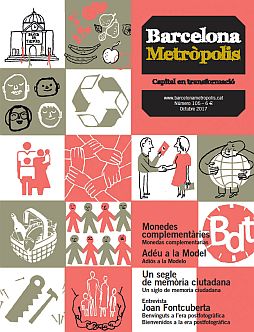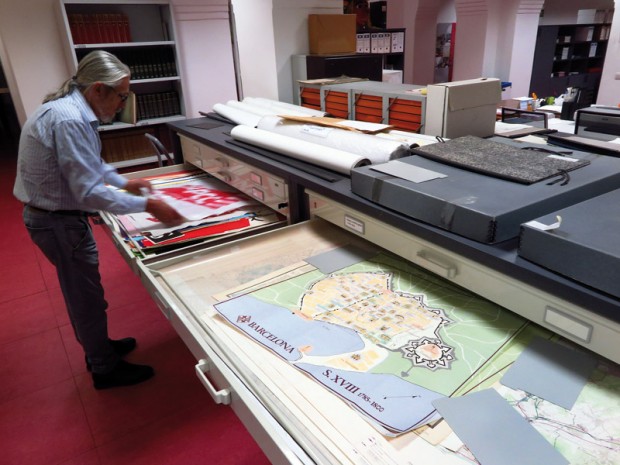
Facilities at the Arxiu Municipal del Districte de Sants-Montjuïc (Municipal Archives of the Sants-Montjuïc District), one of the municipal archives that now house the historical collections of citizen’s organisations in each area.
Photo: Vicente Zambrano
A century ago, on 21 June 1917, the decision was taken to split the Municipal Archive of Barcelona (AMB) into two sections — one administrative, the other historical. The latter of the two would go on to become the Historical Archive of Barcelona (AHCB), established in Casa de l’Ardiaca under the direction of Agustí Duran i Sanpere. Alongside the AHCB, civil society organisations have also done invaluable work to preserve the historical memory of the city.
In 1917, Barcelona City Council’s Culture Commission created a municipal department — the Office for Historical Publications and Research — that would have a decisive effect on the course of historical research in the city. The Office was led by the historian, archiver and archaeologist Agustí Duran i Sanpere (1887-1975), under the political direction of councillor and Noucentisme poet (a Catalan cultural movement of the early 20th century), Jaume Bofill i Mates. That same year, the Office would launch a project to split the Municipal Archives into two sections: one administrative, the other historical. To house the historical collections, the City Council bought and renovated the Casa de l’Ardiaca, which opened its doors in 1922 as the home of the new Historical Archive of Barcelona, also headed up by Duran i Sanpere.
Decades before, the Municipal Archive of Barcelona had become established as a major institution, not only for preserving the city’s documentary heritage but also for promoting research into and dissemination of its historic past. From 1892, it was the agency tasked with publishing the monumental work Manual de novells ardits (Handbook of New Schemes), which restored the use of the Catalan language in the City Council’s official publications.
From 1884 onwards, and at the behest of the Academy of Fine Arts, the Archive was involved in an ambitious plan to raise awareness of its collection, with support from the academics Josep Pella i Forgas, Francesc de Bofarull and Felip Bertran, and the municipal archivers Lluís Gaspar, Josep Puiggarí and Alfons Damians i Manté. This latter archiver, alongside the young Duran i Sanpere, was in charge during the first 1917 reorganisation of the Municipal Archive — now obsolete — when the documents dating back before 1714 were separated from the rest of the collection following the creation of the Historical Archive. In the shadow of the ever-present figure of Duran, the archival work of Damians i Manté has largely gone unnoticed, despite constant praise from his successors as head archiver — Ramon Alberch, Montserrat Beltran and Joaquim Borràs — since the restoration of the democratic City Council.
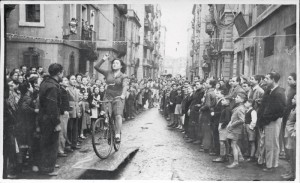
A gymkhana at a neighbourhood fête in El Raval in the 1930s.
Photograph: Arxiu Municipal del Districte de Ciutat Vella (Municipal Archives of the Ciutat Vella District).
From 1917, during the mid-20th century and until the restructuring of the municipal archive system in 1988, the Historical Archive of Barcelona was the main cultural body responsible for the dissemination of urban history — until the 1929 Barcelona International Exposition: it was later joined by the History Museum created by the Francoist City Council in 1943 (it is no coincidence that it was inaugurated on 14 April — the date on which the Second Spanish Republic had famously been declared in 1931), also under the direction of Duran i Sanpere.
In parallel to the work carried out by the City Council to preserve, document and disseminate the city’s cultural heritage, other entities also took steps to safeguard it, such as the Catalonia Hiking Centre (CEC), which inspired other local hiking groups to set up their own neighbourhood historical archives. This was the case for the Historical Archive of Gràcia and the Historical Archive of Sants, whose collections ultimately became part of the Municipal Archive of Barcelona. In the 1920s and 1930s, these two neighbourhood archives became the epicentre of efforts to preserve valuable material testimony of the former towns of the plain of Barcelona from before they were incorporated into Barcelona itself. This memory of the city in the form of documents — often related to everyday and cultural life — is of vital importance for the recognition and strengthening of collective identity.
Gràcia, El Raval and Les Corts
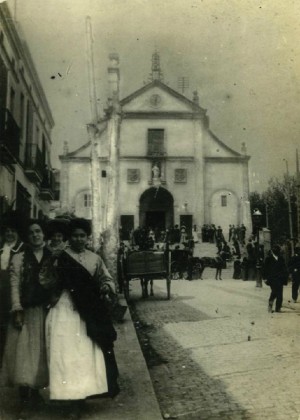
The church of Els Josepets in Gràcia, after mass, one Sunday in the early 20th century.
Photo: AMD de Gràcia / Club Excursionista de Gràcia
Thanks to the encouragement of figures such as Josep Buch i Parera and Eudald Canivell, Gràcia gained its first Historical Archive during the dictatorship of Primo de Rivera, with the aim of strengthening historical memory. An interesting example is what happened to the magazine published by the Hand Weavers Cooperative during the Second Spanish Republic. In January 1939, after Franco’s troops occupied the city, the heads of the Cooperative decided to destroy all the copies of the magazine published during the Civil War. If the current Municipal Archive of Gràcia has preserved a complete copy of all the editions published by the Cooperative during the Civil War, it is thanks to the Hiking Club’s old historical archive, which zealously saved copies for future generations.
The Franco dictatorship, as in so many other aspects of daily life, signalled a before and after for local research. During much of the 1940s, the exile and repression of Catalan culture bolstered the spirit of initiative that had given rise to previous advances in the interwar period. The much-feared official censors — not to mention the self-censorship imposed by the authors themselves — effectively determined the type of local research and historical studies undertaken. This scenario did not begin to change until the 1970s. What happened in El Raval is an example of similar developments in other districts: thanks to the Fifth District Residents’ Association, established in 1974 and later known as the El Raval Residents’ Association, the first El Raval Study Centre was launched. With the involvement of young local graduates like Joan Fuster i Sobrepere, Xavier Suñol, Jaume Artigues and Francesc Mas, works such as the pioneering El Raval: Història d’un barri servidor d’una ciutat (El Raval: History of a City’s Service District) (1980), were published, bringing the historical, dissenting and social visions of their authors to the fore. Books such as Tots els barris de Barcelona (All the Districts of Barcelona) (1976), by Josep M. Huertas and Jaume Fabre, had a major influence.
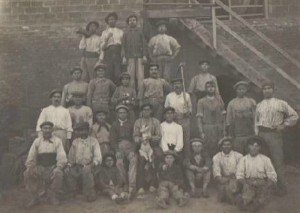
Workers in a brickyard in Les Corts in the 1900s.
Photograph: Arxiu Municipal del Districte de les Corts / Col•lecció de la família Brengaret-Framis (Municipal Archives of the Les Corts District / Brengaret-Framis family collection).
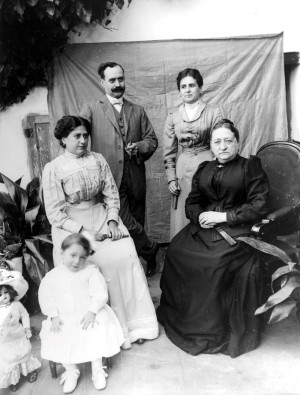
A well-to-do family in Les Corts in the early 20th century.
Photograph: Arxiu Municipal del Districte de les Corts / Col•lecció de la família Brengaret-Framis (Municipal Archives of the Les Corts District / Brengaret-Framis family collection).
A few years later, on the other side of the city, in an area facing very different urban challenges, the Les Corts Study Centre was also contributing to the protection of local historical and cultural heritage. The Centre was set up by a group of university lecturers, including Josep Moran, Ramon Cerdà, Josep Mas i Sala and Josep Maria Casasús, for a specific purpose: to create a Historical Archive for Les Corts, “established to collate and safeguard written and illustrated documentation about the area, and promote its scientific study and dissemination of its history”. Sure enough, the archive was set up and, later, incorporated into the new Les Corts Municipal Archive.
The first meeting of the neighbourhood historical archives
On 16 April 1983, Casa de l’Ardiaca organised a historic event for the new study centres throughout the city, many of which had been created at the end of the Franco dictatorship. Launched by Jaume Sobrequés, director of the Municipal Institute of History, the first meeting of the neighbourhood historical archives was attended by members of the archives of Sant Martí, Horta, Les Corts, El Raval, Sants-Hostafrancs, Sarrià, Sant Gervasi, Gràcia and Sant Andreu. A number of proposals were suggested at the meeting, some of which were put into practice as part of the City Council’s decentralisation plan, such as creating a network of municipal historical archives (the district archives) and restoring the historical document collections of the old outlying municipalities.
In 1997, the centenary of the inclusion of the surrounding towns into the city of Barcelona signalled a new milestone for local research, as did the 2009 centenary of the so-called Tragic Week, a series of violent confrontations between the Spanish army and anarchists and republicans in Barcelona and other Catalan cities; and the 2014 tercentenary of the Spanish War of Succession. In addition to the official events promoted by the institutions, study centres such as the Ignasi Iglésias centre in Sant Andreu were instrumental in broadening the historical vision of those events with various interesting initiatives, including an exhibition and a monographic publication to examine the events of 1714 from the perspective, not of Barcelona, but of the former town of Sant Andreu del Palomar.
The resurgence of local research
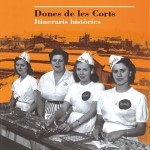
Cover of the book Dones de les Corts, a tour of the neighbourhood’s history seen through the eyes of women and written by the historian Isabel Segura Soriano and jointly published by the district archives.
Photo: Ajuntament de Barcelona
Local research in Barcelona is currently seeing a new resurgence and is supported by specialised institutions such as the Ramon Muntaner Institute and the Coordinating Committee for Catalan-speaking Study Centres. This was amply demonstrated at the meeting organised by the Municipal Archive of Barcelona and the Passats Presents Institute, held on 17 June 2017 at the El Born Cultural and Memorial Centre on the theme of research challenges and opportunities.
In addition to integrated research organisations and associations such as the Ignasi Iglésias Study Centre, the historical archives of Poblenou and Roquetes, the history workshops in Gràcia and Clot-Camp de l’Arpa, the Poble-Sec Historical Research and Study Centre and the Montjüic Study Centre, it is necessary to add newer, more ambitious initiatives such as the Tot Història Cultural Association, the Sant Martí de Provençals Study Centre and the Fort Pienc and Barceloneta history workshops.
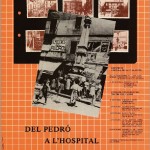
Poster for the exhibition and talks on ‘Del Pedró a l’Hospital’, organised in 1981 by the Arxiu Històric del Raval (Historical Archives of El Raval).
Photograph: Arxiu Municipal del Districte de Ciutat Vella (Municipal Archives of the Ciutat Vella District).
The technological revolution and the new digital resources that public and private archives offer for those interested in the city’s history have turned what we knew about local research on its head. Good examples include online projects like the blogs Barcelofília. Inventari de la Barcelona desapareguda (Barcelophilia: Inventory of a Bygone Barcelona), by Miquel Barcelonauta; La Barcelona oblidada (Forgotten Barcelona), by Enric Comas; El tranvía 48 (Tram No. 48), by Ricard Fernández Valentí; Modernisme (Modernism), by Valentí Pons; and Memòria de Sants, (Memories of Sants), by Agus Giralt.
Each with their own particular lines of research, local study centres and, increasingly, new Internet researchers are undertaking research into topics that would otherwise be left out of academic studies. “We need to work as a network” was the recurring theme of the talks given by Ricard Vinyes, Curator of Historical Memory Programmes, and Joaquim Borràs, Head of Archiving for the City Council, during the meeting at the El Born Cultural and Memorial Centre.



